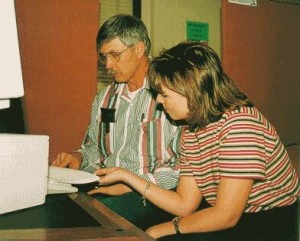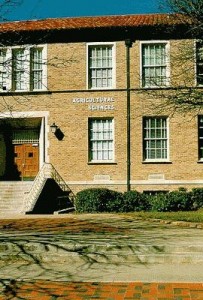By Pamilyn Scott

Dr. Phillip Johnson and Research Assistant April Clark examine the financial information of a participant in the Standardized Performance Analysis. Photo by Pamilyn Scott
A crucial aspect of farming is discovering the profitability of an operation through record keeping efforts. Thanks to funding provided by the Texas State Support Committee for Cotton Research, Cotton Incorporated and the Cotton Economics Research Line-Item at Texas Tech University, an effort is underway to assist farmers in this aspect of farm management.
The Department of Agricultural and Applied Economics at Texas Tech and the Texas Agricultural Extension Service are developing a Standardized Performance Analysis (SPA) that will enable farmers to analyze the financial and production performance of their operation
A unique characteristic of SPA is its ability to process information for a total operation including crop and livestock enterprises. It also has the capability of dividing the operation into sub-enterprises. For example, a farmer can evaluate one section of his operation such as dryland or irrigated cotton, soybeans, milo, or livestock to see where his costs and profitability occurs. SPA allows producers to identify potential changes in their operation that may lead to improved performance and increased profits. According to Dr. Phillip Johnson, assistant professor at Texas Tech, SPA is the only program that allows a farmer to make this specific of an evaluation on all aspects of his operation.
“SPA gives the farmer information to analyze profitability in his ownoperation,” Johnson says. “We’re interested in the results to see what is happening in the cotton industry.”

The Department of Agricultural and Applied Economics is located in the Agricultural Sciences building at Texas Tech University. Photo by Wendy D. McDaniel
SPA is in the field testing stage which began in the summer of 1996. The SPA analysis is being performed at Texas Tech by Research Assistant April Clark. Currently, there are 19 participants who have provided 1995 financial information for the program which is kept confidential.
“The feedback from farmers using SPA has been positive,” Clark adds. “Everyone says they will participate in the SPA program again for their 1996 crop.” All information gathered through SPA will be placed into a data base which, according to Johnson, takes years to create. Thus, an accurate data base will not be established until there has been enough participation to assure results represent producers within a region.
“As we continue to build a data base of results from all farmers using SPA, a person can compare his operation to others,” says Johnson. Using the data base, farmers will be able to compare information within a county, region or throughout Texas.
“After the field testing stage is completed, we will have a computer program to provide farmers and financial professionals,” Clark continues. Farmers will not be the only ones benefiting from SPA. As information is gathered and placed into the data base, cooperatives, lenders and anyone interested in the information also will have access to the results.
“The data base will give us information on the actual cost of production for cotton as well as the financial situation of farmers,” Johnson adds. As more farmers begin to implement SPA, educational and training programs will be necessary to instruct farmers on the use of the software, which is IBM compatible. Johnson hopes SPA will be available for farmers within a year.
The original SPA was developed by Texas A&M University and the Texas Agricultural Extension Service at the request of the National Cattlemen’s Association as a management tool for cow/calf producers. At the time, the National Cattlemen’s Association wanted to help cow/calf producers identify areas of their operation needing improvement in order to increase profits and manage their operations more efficiently. Compiling a data base of the results allowed producers to make comparisons with other producers in Texas and the U.S., and the success of SPA led to its expansion into crops.
Clark recently presented the progress of SPA at the Beltwide Cotton Conference in New Orleans. People involved with the cotton industry in the aspects of government, education, and production attended the presentation. According to Clark, people had heard what the program could do, but they were not familiar with all of its capabilities.
“We wanted to expose the program so everyone could see what SPA can actually do,” Clark notes. “There seemed to be a lot of interest and positive feedback from the audience.”
Anyone interested in the Standardized Performance Analysis should contact Dr. Phillip Johnson or April Clark with the Department of Agricultural and Applied Economics at Texas Tech University at P.O. Box 42132, Lubbock, Texas, 79409-2132 or call 806-742-0261.


